Manali To Leh (Khardungla) Cycling Expedition

Region
Ladakh | India

Duration
12 Days

Max Altitude
17577 Ft.

Trekking Km
505 KM

Grade
Challenging
Get in Touch with Our Trek Expert
91 8191004846 info@trekthehimalayas.comMonday - Saturday: 10 AM to 09.30 PM (GMT +5:30)
Sunday: 10 AM to 05.30 PM (GMT +5:30)
40000 /Person
Get in Touch with Our Trek Expert
91 8191004846info@trekthehimalayas.com
Monday - Saturday: 10 AM to 06 PM (GMT +5:30)
Overview
Trek Name: Manali To Leh (Khardungla) Cycling Expedition
Days: 12
Adventure Type: Multi Sports
Base Camp: Manali
Season:Monsoon |
Month:June |
Country: India
Altitude: 17577 Ft.
Grade: Challenging
Rail Head: -
Stay: Camping (Twin sharing) & Hotel/Guesthouse
Food: Meals while on cycling trip (Veg + Egg)
Location: Ladakh
Distance: 505 Km.
Trail Type: Cross over trail | Start in one valley, traverse the pass, and ends in another valley.
AirPort: Bhuntar, which is 52 km away from Manali
Highlights:
- 5% GST will be applicable on Trek Cost and Add-ons
- Services Manali to Leh
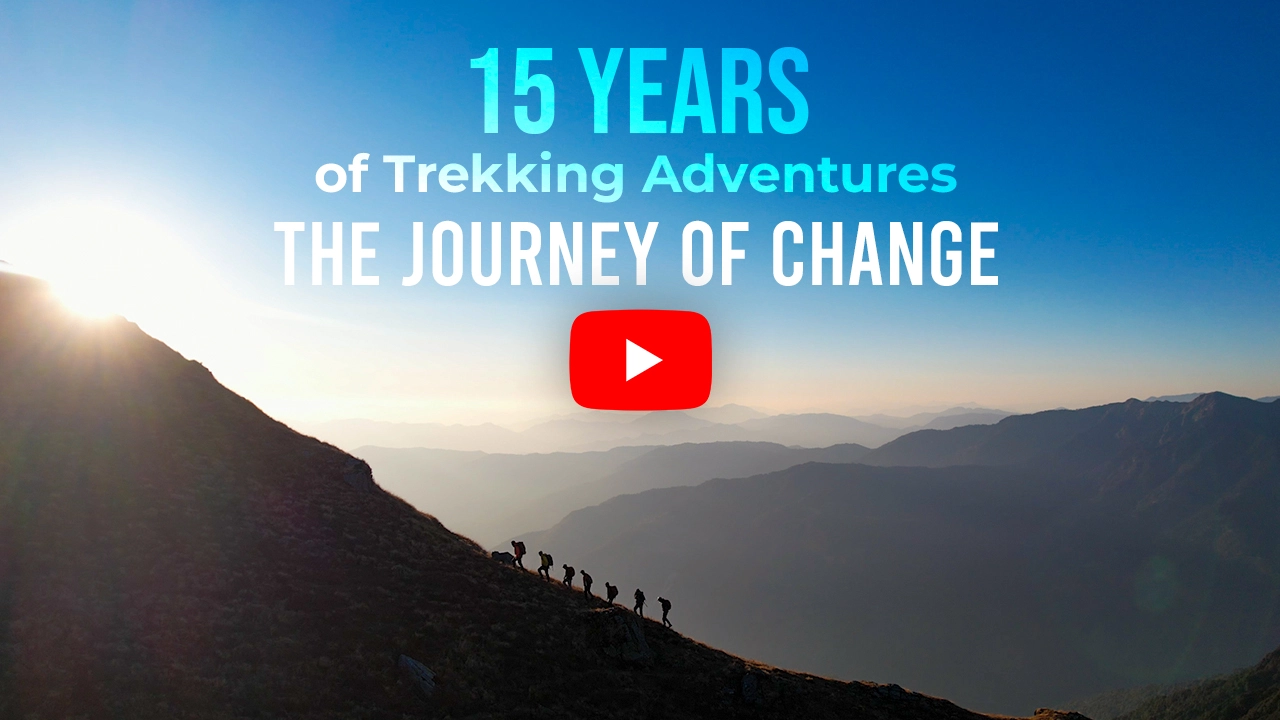
Why is Manali to Leh Cycling Expedition a Must-Do?
Cycling in the Himalayas is altogether a different experience which can be one of the wildest dreams of an adrenaline junkie. If you have the zest for conquering the spellbinding world of the Himalayas by riding your cycle, then the Leh-Manali Cycling Expedition should be on your bucket list. Placed amid an ever-changing and fabulously flourishing backdrop, the Himalayan ranges tender some spectacular cycling trails for adventure aficionados. To put it briefly, a cycling trip in the Himalayas is an ideal vacation idea for those who are born to be wild.
As a cyclist who always dreams of riding his cycle to dream destinations the cycling expedition from Malani-Leh surely promises to be a ride to remember. This expedition lets you cover two states in the northern part of India which are Himachal Pradesh and Jammu and Kashmir. You will also be crossing three of the highest motorable passes in the world including the Khardungla Pass. As you start your expedition from Manali and then move forward towards Leh, you’ll be witnessing a huge difference in the landscape that changes from time to time. Tall mountains peeping behind each other with brown texture will greet you as you start approaching Leh.
You must have proper safety equipment while riding your cycle in the mountains as it is a different ball game when compared to riding it in the city. Physical fitness, as well as mental fitness, go hand in hand for an expedition like this in the Himalayas.
CyclingExpedition/VideoThumb/877edc78-c716-4f6b-b3ea-81302e352d18_Manlithumbnail.webp)
Who Can Participate
- Age Requirement:
- Minimum 16 years
- First-timers are welcome, though prior trekking experience is preferred. Good fitness is a must.
- Fitness Criteria:
- If the trekker wants to carry a backpack then he/she should be able to carry a 10-12 kg backpack. If opt Off-load option then the Trekker should be able to carry 3-5 kg backpack.
- If a trekker's BMI is more or less than the normal range (18-26), please consult our Trek Coordinator before booking.
Manali To Leh (Khardungla) Cycling Expedition Itinerary
Arrival Manali
The cycling expedition starts from Manali, so you have to reach the location a day before your expedition begins. The first day of the trip is reserved for the participants to arrive at Manali and get settled into their accommodations.
After reaching Manali on the first day, your accommodation will be taken care of in a guest house which will be arranged by TTH. Get done with your lunch after which you will get some time for interaction with your fellow participants. Your leader will brief you about the expedition which will include the safety measures and the regulations that need to be followed. Spend some time in the evening exploring the nearby area in Manali. Dinner will be served at your guesthouse.
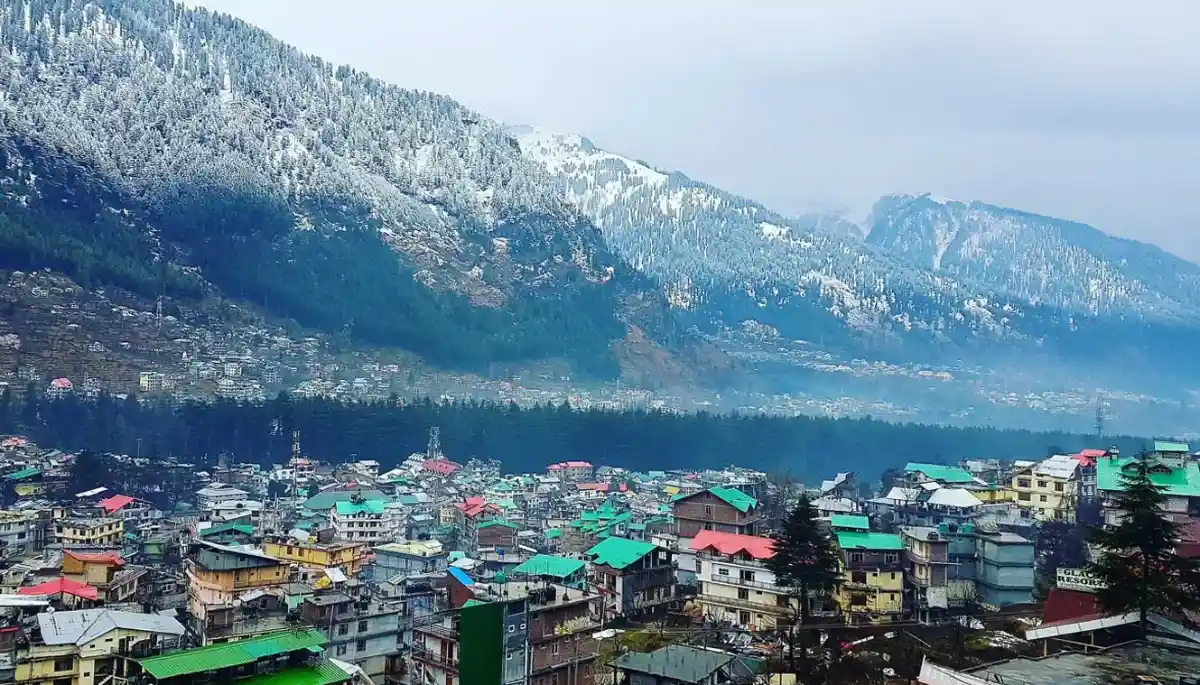
Manali To Marhi
Today marks the beginning of your cycling adventure. After having your breakfast we will embark on the long-waited tour. We will ride from Manali to Marhi. Marhi is approximately 35km from Manali, lying between Manali and Rohtang Pass on the Manali - Leh highway, and on the way, you’ll come across some stunning views of pine and deodar forests and flower-laden valleys. Marhi is also paragliding opportunities for tourists starting from Marhi towards Gulaba. Gulaba, Kothi, and Palchan are some of the most scenic spots that we will cross on our way today. It is important to start our day early so that we av
avoid the traffic at Rohtang pass.
The route to Marhi has a lot of hairpin bends so it is important to be a bit cautious. The hairpin bends can make the journey a bit strenuous but it also prepares you for the upcoming days of cycling. The picturesque roads, the views, and the freshness along the route will definitely take your tiredness away. The campsite at Marhi is a scenic place which offers some pretty views. You will get some of the best views of the Pir Panjal Range from the campsite. We’ll be camping here for tonight and your dinner will be served at your campsite.
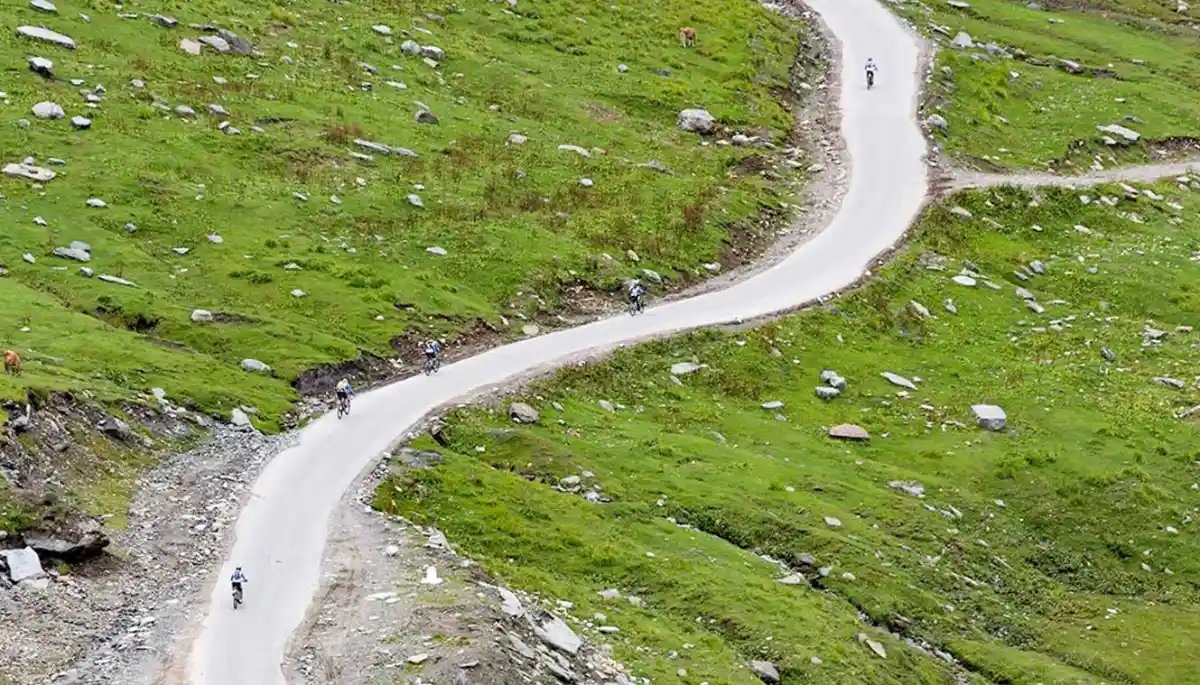
Marhi To Sissu via Rohtang Pass
From Marhi our next stop is Sissu via Rohtang pass. We start off our day by having our breakfast and then finishing a 17km ascent to the top of Rohtang pass. Rohtang is the first of the five passes that we will cross on our way to Leh. It is one of the most popular tourist attractions in Kullu and is a part of the Pir Panjal Range. You will come across some spectacular views of the snow-covered mountain peaks of Spiti Valley as well as the Chandra River from the pass. Rohtang is covered in snow for most of the year and it is a distinct gateway to Ladakh. The pass is so spectacular that it has been part of some major blockbuster Bollywood movies as well. We will take a halt at Rohtang pass for some refreshment after which we’ll have to make the descent to Gramphu.
The descent from Rohtang Pass is nothing short of unchartered thrill and joy. As you ride downhill, the breeze in your hair will fill you with childlike happiness. Cycling along the Chandra River, you will arrive at Gramphu. From Gramphu it is a ride along flat roads to Sissu. Sissu is also known as Khwaling which is a small town in Lahaul valley on the banks of the river Chandra. En route to Sissu, you will also cross the torrents of Chandra River at Khoksar. Lahaul comes like a breath of fresh air for those who love wandering amidst the mountains. It is quite different from Ladakh and brings with it, its own set of culture, traditions, and folklore.
Sissu attracts a lot of tourists owing to its natural beauty and the breathtaking view of a waterfall, locally known as Palden Lhamo Dhar. Sissu has many resorts and homestays as well, as it serves as the town center for nearby villages including Labrang. Sissu also serves as the gateway to three famous Himalayan regions - Lahaul, Spiti, and Ladakh. At Sissu, we’ll be camping for the night where you will be served your dinner. Relax after a tiring day because you’ll be up fresh the next day for new adventures.
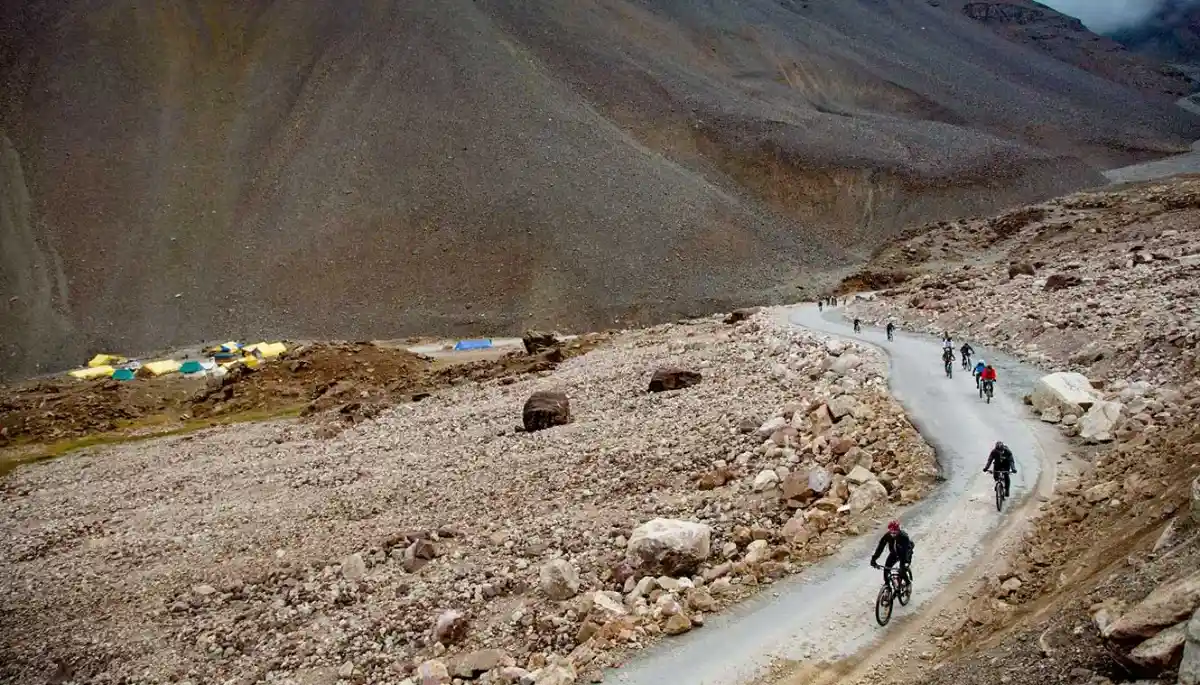
Sissu To Jispa
Today we’ll be riding all the way up to Gondla which is at a higher elevation from Sissu and make it to the quaint and sleepy hamlet of Jispa. It\'s a gradual route from Sissu for around 8-10 km, where it gets uphill for around 20 km or so, later stretching to Jispa. Gondola is situated 18 km before Keylong. This village is full of greenery and surrounded by waterfalls with the dense vegetation of Poplar. Gondola also showcases a 300-year-old fort, which is a seven-story building depicting the ‘Kath-Kuni’ type of architecture (Kath meaning wood and Kuni meaning corners). From Gondla we’ll be descending all the way to Tandi.
Tandi is a prominent village of Himachal and is located at the confluence of the Chandra and Bhaga rivers that flows downstream in Jammu & Kashmir by the name Chenub. This area is the Chamba Valley. Tandi has some interesting mythology connected to it as well. According to folklore, the sun of moon good Chandra and the daughter of Sun God Bhaga eloped and married here at Tandi. It is also believed that Tandi is the place where Draupadi left her body and another story runs that sage Vaishistha who meditated near the hot springs of Manali was cremated here. Located on the Manali-Leh highway and 8 km before Keylong, Tandi also has a fuel station where travellers can fuel up their vehicle if they want to travel further north of Keylong.
After crossing Tandi we will go past Keylong which is a low gradient all the way up to Jispa. It is advisable to drink lots of water at high altitudes which helps to maintain blood circulation. There will also be a support vehicle so that you can refill your bottles when needed. On the highway, you will come across freshwater streams which are cool and refreshing. Keylong is a village which is situated halfway between Sissu and Jispa. We’ll take some rest at Keylong where you will be having your lunch and then move forward. Keylong is the district headquarter of Lahaul & Spiti and is situated between the main trade routes between Rohtang and Baralacha passes. It is also home to several Buddhist monasteries as well. If you want to purchase local handicrafts like Kullu shawls, Lois, baby shawls, etc this is the ideal place for shopping. As soon as you cross Keylong you will notice the change in the mountain ranges where the vegetation part is taken over by dry desert. Watch out for stones that are rolling down the road. After a few kilometers of uphill, we finally reach Jispa. On the banks of the river Bhaga, Jispa is a peaceful village in the Lahaul valley which is located 20km north of Keylong. The riverside mountain village of Jispa is sure to leave you breathless. We will be camping here for the night.
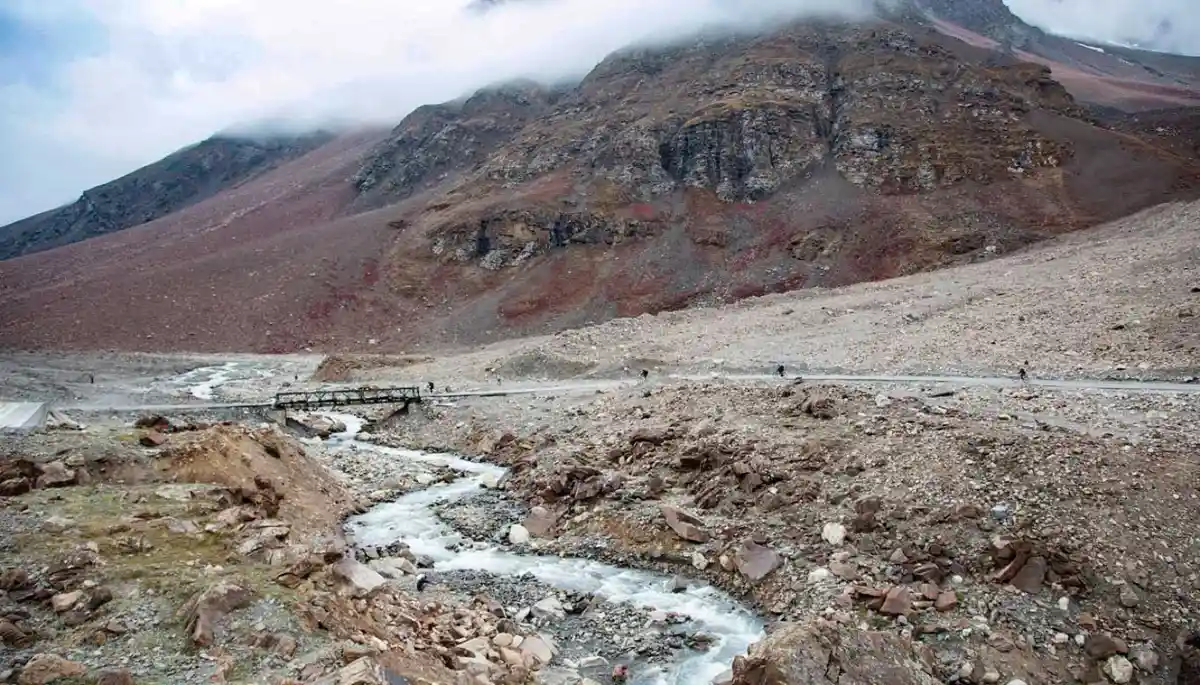
Jispa To Zing Zing Bar
After having your breakfast we will be heading to Darcha which is about 10km from Jispa. Today’s climb can be a little difficult as we will be gaining a considerable amount of altitude. The road climbs steadily on this route on the way to Patseo. Patseo is a military checkpoint with a few soldier tents otherwise it is entirely a desert region surrounded by dry mountain peaks covered. You will have to be a bit careful on this road as it is rocky so it important that you maintain the speed that you are comfortable with. You will start noticing less civilization from here on and it will strike you how disconnected this place is from other places and the scenery begins to get arid as well. You will start seeing glimpses of the higher Himalayan range which offers a view of snow-covered peaks.
We will start gaining altitude from here on and you will feel the cold so it is important to have a proper layering of clothes. The final ascent is to Baralacha-La starts at Zing Zing bar. Zing Zing Bar is located at an altitude of 15000 ft and presents some of the most beautiful views en route. Your campsite will be pitched at some distance from Zing Zing Bar where you will stay for the night. Hot soup will be provided to you before you have your dinner. It is important to get the much-needed rest before you set out for the following day.
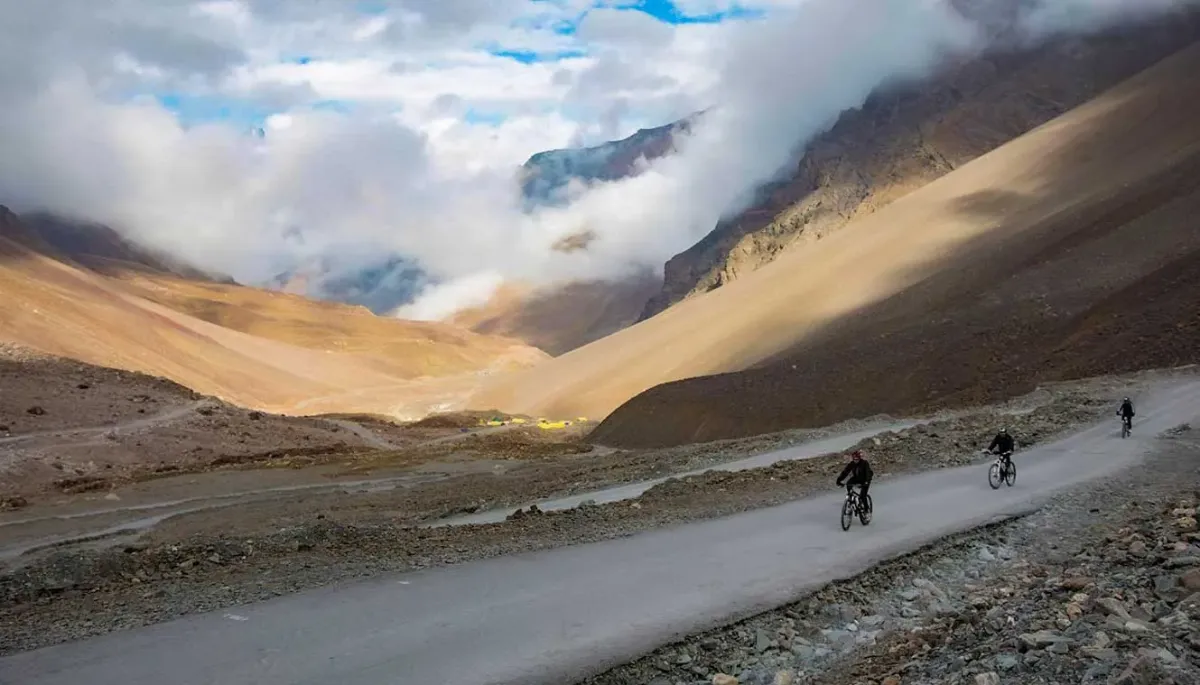
Zing Zing Bar To Sarchu via Baralacha La
After having your breakfast we’ll have to start our day early today as it is a 65 km stretch. You will sense that the entire surrounding changes into a dry desert and there are no signs of green. Today we will cross the second of the high passes on your itinerary. At a height of 15,900 ft, Baralacha pass feels cold with strong winds blowing from time to time. Baralacha La Pass is an important location for bikers and cyclists alike. This pass is quite unique in its own right as it is the meeting point of the Zanskar Range, Pir Panjal Range, and the Great Himalayan Mountain Ranges. The serene flow of the river and the majestic mountains surrounding will amaze you for the rest of the journey. Take some time to click pictures and soak at the moment. Surya Tal is a famous spot point on the Bralacha Pass, the third highest lake in our country and the 21st highest in the world. En route, you will also spot Deepaktal, a high-altitude glacial lake before Baralacha La. The water of the lake remains calm reflecting the beautiful surroundings nearby. Deepak Tal often serves as a retreat for the riders who pass by the route.
After having your lunch we’ll be heading to Sarchu, which marks the border between Himachal Pradesh and Jammu & Kashmir. The landscape still remains the same as earlier with tall barren peaks surrounding you. The entire route then descends gradually to the wide Sarchu Plains. Sarchu lies exactly between Baralacha La Pass and Lachung La Pass. Sarchu often serves as the rest stop between Manali to Leh. We will be camping at Brandy Nallah for the night which is at some distance from Sarchu.
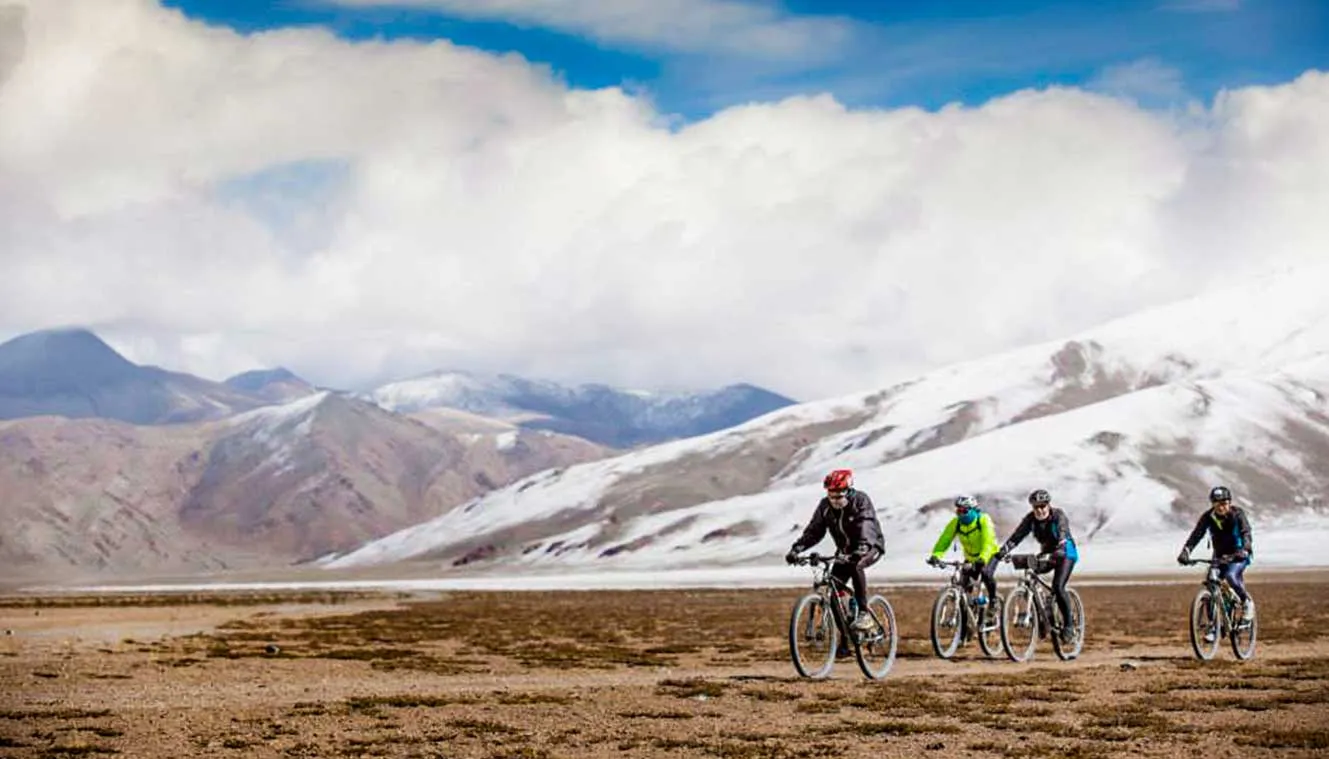
Sarchu To Pang Via Nakee La, Lachung La
Brandy Nala to Pang is perhaps the most difficult day when we will be riding past the Gata loops which are a series of 21 hairpin bends that cover a distance of 7km. Brandy Nala lies at the base of the Gata Loops and you will come across a board that marks the beginning of Gata Loops. As you climb higher the loops below are visible which look flat. You will be relieved after crossing the loops as it takes a huge toll on your body and your fitness is tested as well. The ride to the top of the loops is one that will have your heart skip many beats. Ensure to carry enough water with you as there are no water sources on the way. Reaching the top of the Gata Loops is going to leave even the cycling aficionados exhausted. But the adventure does not end here. We’ll also be crossing Nakee la and Lachung la both on the same day and it would be one adventurous ride of your life. After having your lunch we will go past Nakee la where the mercury level dips down. Keep cycling along the route to Nakee La, and even though the road may seem never-ending at times, you will soon come across the prayer flags, which means that you are now close to the Pass. Nakee La is the third-highest pass on the Manali-Leh highway.
From Nakee La a 7 km zig-zag climb will lead you to the top of Lachung La, another high pass on your way to Leh. Descending down from Lachung La, you will soon arrive at Pang which will be our camping spot for the night.
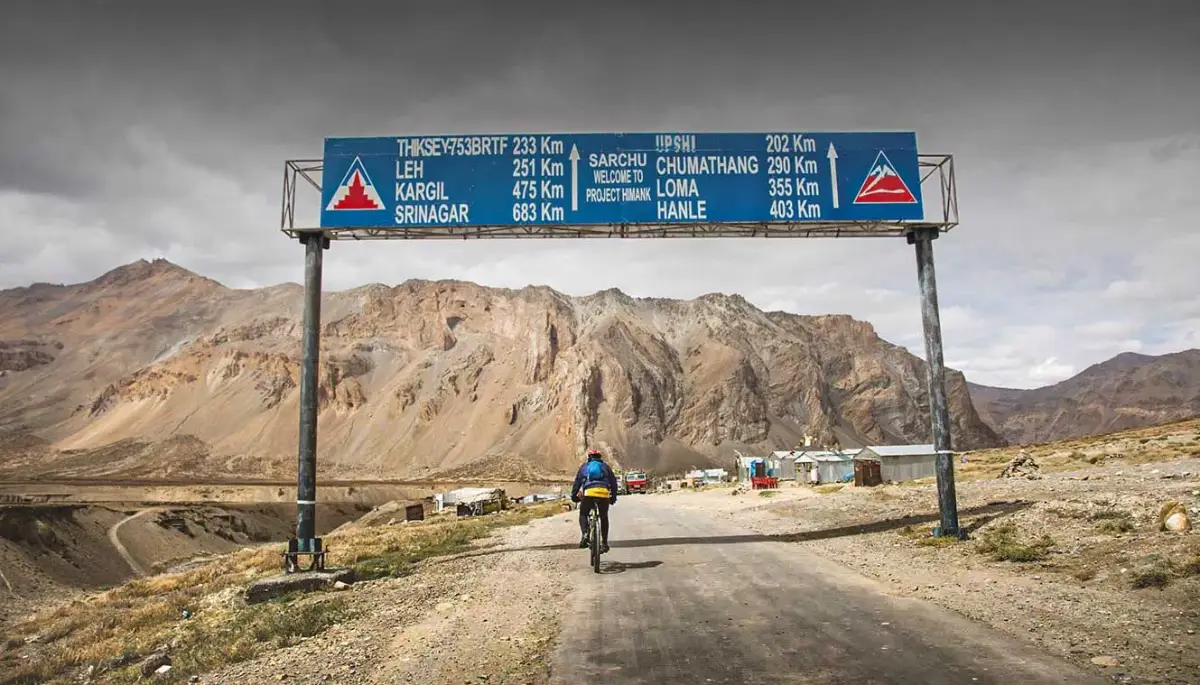
Pang To Debring
Your day will start with a 7 km ascent to Tanglang La which is followed by a long descent along a steep gorge to Pang. Pang has some military transit camps and at 15,640 ft, they are said to be the highest army transit camps in the world. Morey Plains which is at a height of 4,700 m is an 8 km climb from Pang which is known for extreme temperatures both in the morning and in the evening. You will come across some nomadic Changpas with their yaks. Apart from them, there is no sign of civilization. The expansive area is extremely isolated. The Morey plains are some 40-odd km long and this will be quite easy on your legs after cycling along steep routes and the rugged mountain terrain. You will enjoy some breathtaking views as you cycle along the plains. The plains are flanked on both sides by rocky mountains and rock formations. You can expect powerful winds while riding along the plains and this can make cycling a little difficult. Tso Kar lake is the first choice of camping but in case the route is close we will be camping at Debring which is at Tanglang La, the world’s second-highest motorable pass.
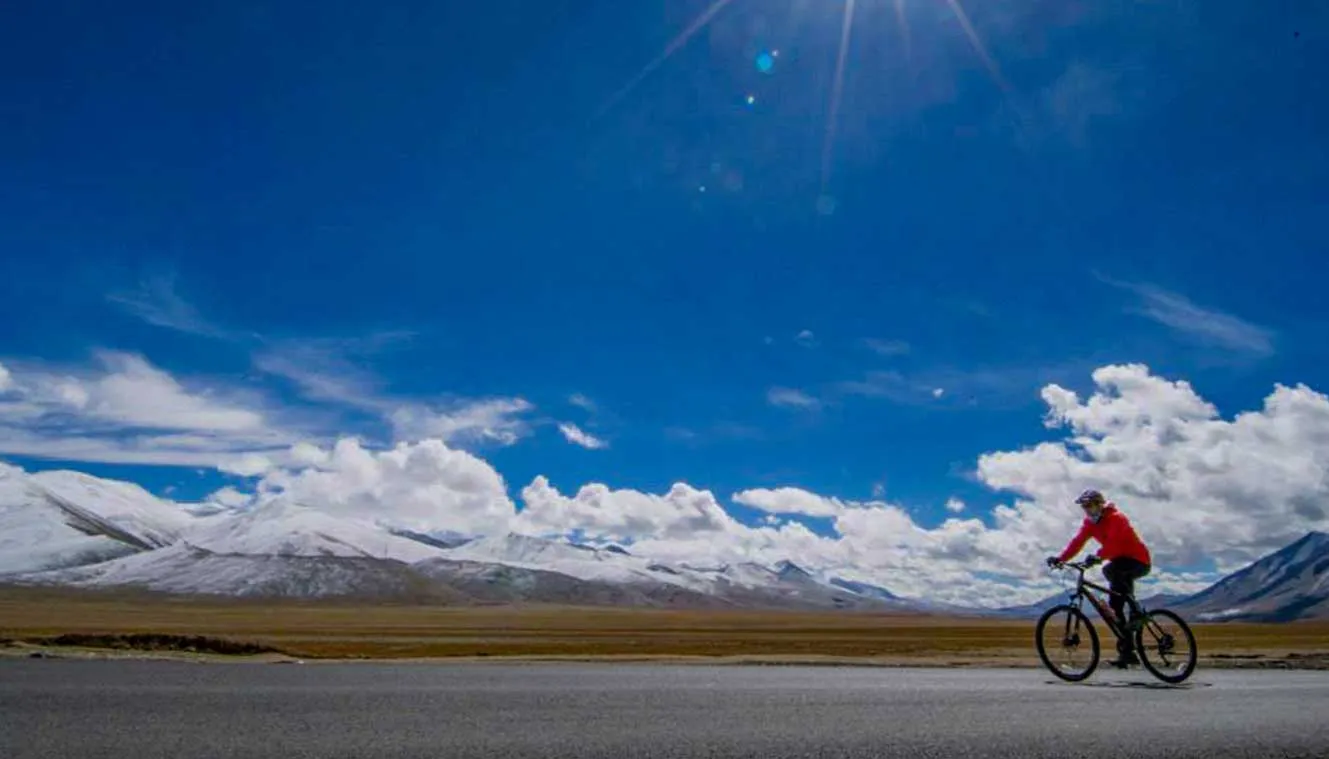
Debring To Rumtse Via Tanglang La
Today, you will be facing a challenging climb that will lead to the world’s second-highest motorable pass in the world, Tanglang La. These are surely testing times and you will have to put in more effort than ever. But what we can surely promise you is that after reaching the top, there are few feelings that can match this. Tanglang La is quite different than all the other passes that we have crossed till now. Crossing this pass, you will not have switchbacks to gain altitude rather you will gradually ride your bicycle uphill, which can be a little strenuous. It will take quite a few hours of laborious pedalling to reach the top of the Tanglang La Pass. The summit of the pass is marked by numerous Buddhist prayer flags. Tanglang La is known to be the residence of ‘Changpa herdsman’, a nomadic tribe that herds cattle, yaks, and pashmina goats here every day. Before we start our descent to Rumtse village, you can take some time to click pictures.
It's a long but smooth descent to Rumtse. You will be entering Ladakh, the land of monasteries, stupas, and jolly people. Rumtse is a spectacular campsite located on the banks of a fast-flowing river and finally, you will see some greenery after a long time.
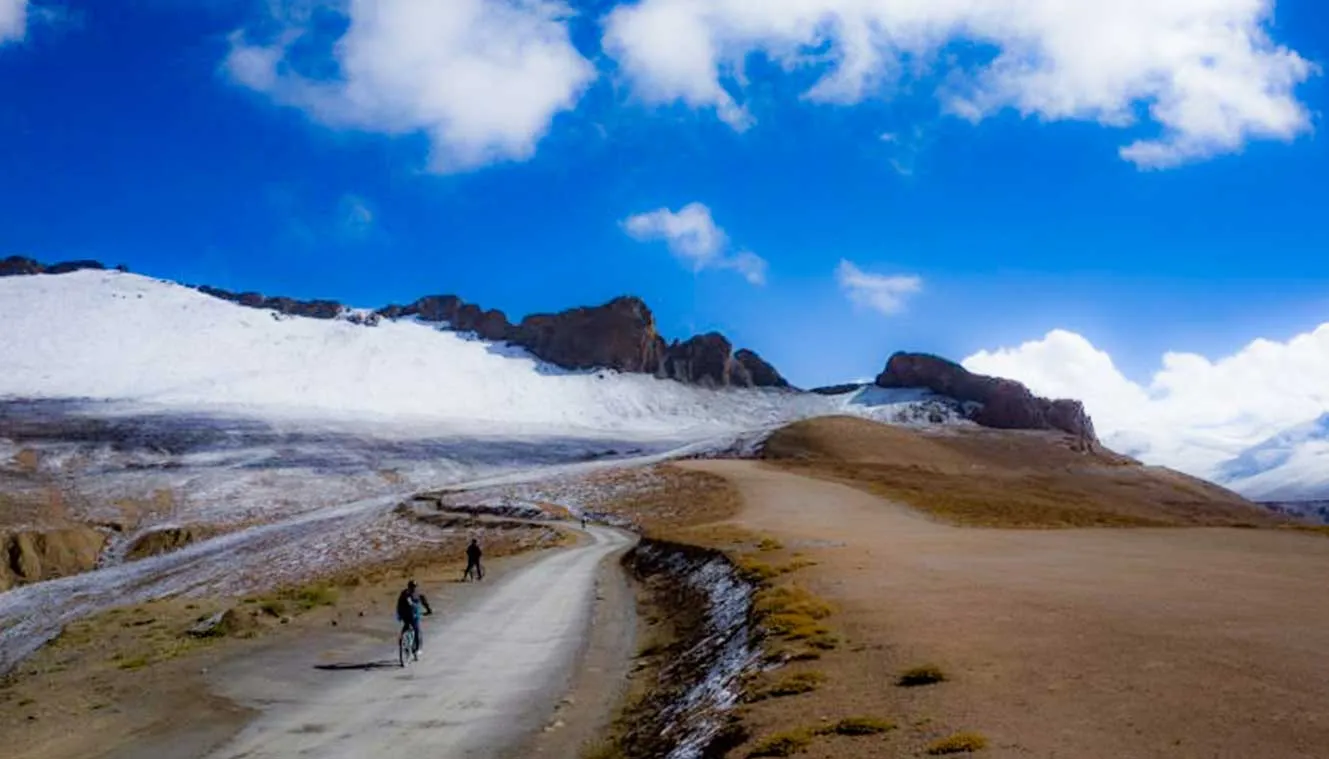
Rumtse To Leh
We will leave Rumtse after having breakfast and our final destination which is Leh will be at a distance of 75km. As we’ll start approaching Leh, a stretch of dusty brown mountains will start appearing from a distance. You have now reached the land of lamas. As you come down from Rumtse you will start noticing some vegetation before Upshi. After a while, you will start getting your first glimpses of the Indus River which is quite a pleasing view. Riding next to the Indus River is sheer bliss. The downhill road to Upshi is marked by some amazing rock formations, the stark purple color of the rocks with the erosion marks is an interesting sight to behold.
We will be taking a halt at Thiksey for lunch which is at a distance of 20 km from Leh. Watching the Thiksey and Shey monastery is an added bonus on the route. From Rumtse, it is a considerably easy ride to Leh and you will spot many army camps on your way. After reaching the guesthouse at Leh you will actually get a sense of satisfaction that you’ve completed the task which you started on Day 1 from Manali. We are sure that you will come back with lots of memories that cannot be expressed in words but will last a lifetime.
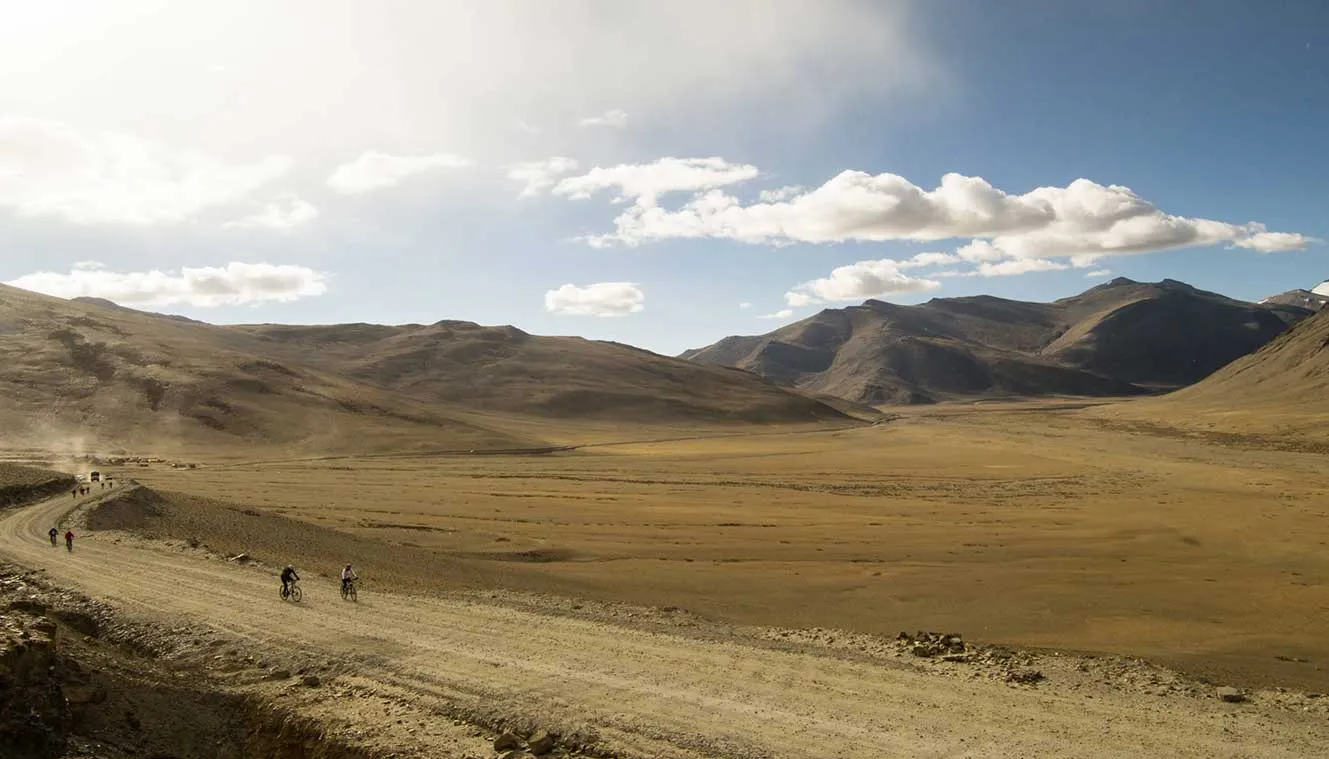
Leh To Khardung La and back
Leh to Khardung La on a cycle makes for a great day trip. The ride up to South Pullu is quite gruesome. As you climb further towards Khardung La, you can see the Stok Kangri peak in the backdrop. The road is in good condition till Khardung La, which also used to be a part of the silk route. It’s quite hot during the daytime so make sure to wear an adequate amount of sunscreen to protect your exposed skin from the harsh sun rays. Carry enough water and keep yourself hydrated. The air is also pretty rare, so catch your breath and keep pedalling! Once you reach close to Khardung La Pass, you start seeing prayer flags from a distance. After one of the toughest bicycle rides of your life, you will arrive at Khardung La, the highest motorable pass in the world. Bask in the joy, ecstasy, and feeling of accomplishment. Click some beautiful pictures and we will head back to Leh and rest for the night.
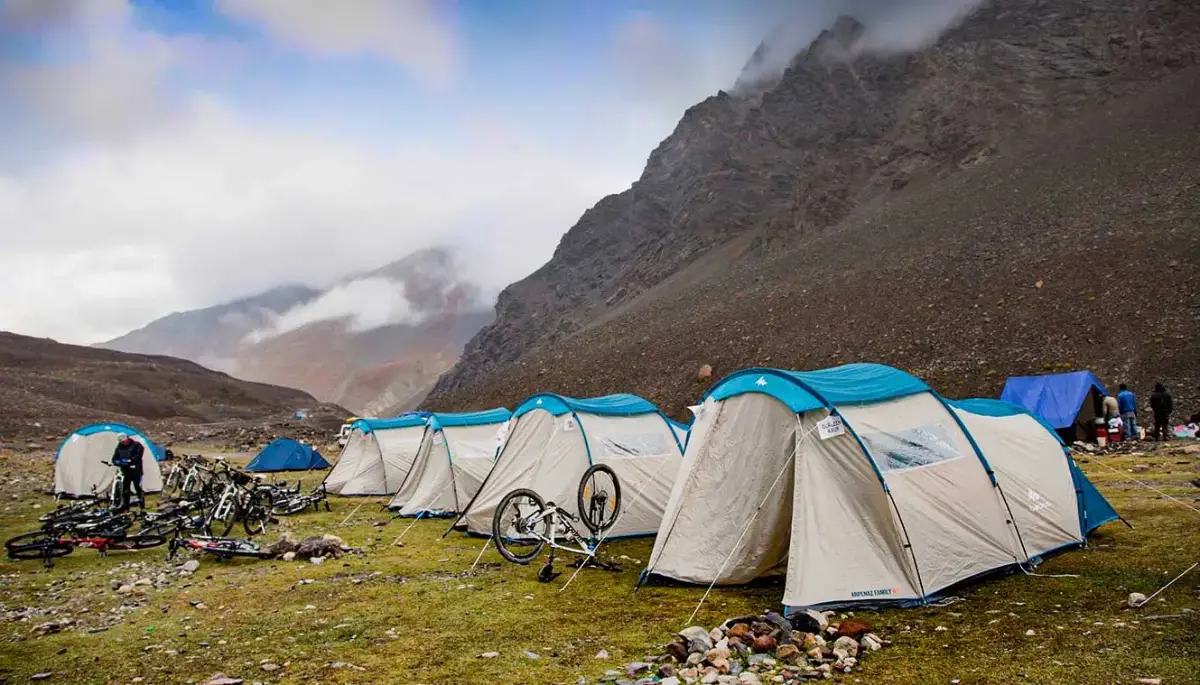
Check out after breakfast
Check out after breakfast
Day-1: Arrival Manali
- Altitude: 2,050 m/ 6,750 ft.
- Distance from Delhi: 530 km | Duration: 13 hrs.
- Check-in at the hotel (12:30 pm).
- Expedition briefing by the leader (post-lunch, approx 3:00 pm).
- All telephone networks are available.
- ATM is available.
- Explore the nearby area in the evening.
- Visit Hadima Devi Temple, Vashist Kund, and other major sightseeing points (avoid Rohtang Pass).
- Only hotel stay is included in the cost (food and sightseeing are excluded).
Day-2: Manali To Marhi
- Altitude: 3,350 m/ 11,000 ft.
- Distance: 35 km | Duration: 7 hrs.
- Altitude Gain: 1,300 m/ 4,250 ft.
- Complete accent with lots of hairpin bends.
- The route has a view of pine and deodar forest.
- Start early in the morning to avoid the traffic at Rohtang Pass.
- Packed lunch on the way.
- Phone networks are available.
- Several shops on the way.
- Stay in tents.
Day-3: Marhi To Sissu via Rohtang Pass
- Altitude: Sissu - 3,100 m/ 10,250 ft; Rohtang Pass - 4,000 m/ 13,050 ft.
- Distance: 50 km | Duration: 7 hrs.
- Altitude Loss: 250 m/ 750 ft.
- Uphill till Rohtang (17 km), downhill till Koksar then gradual ascent till Sissu.
- Phone networks are erratic.
- Several shops on the way.
- Checkpoint at Koksar, keep your ID handy.
- Packed lunch on the way.
- Stay in tents.
Day-4: Sissu To Jispa
- Altitude: 3,200 m/ 10,500 ft.
- Distance: 55 km | Duration: 7 hrs.
- Altitude Gain: 100m/ 250 ft.
- The first 10 km gradual, the next 20 km uphill, rest is a gradual ascent.
- Going through Ghodla, Tandi, and Keylong.
- On the way cross the confluence of Chandra and Bhaga River.
- The phone network is erratic.
- Packed lunch on the way.
- Stay in tents.
Day-5: Jispa To Zing Zing Bar
- Altitude: 4,250 m/ 14,000 ft.
- Distance: 30 km | Duration 6 hrs.
- Altitude Gain: 1,050 m/ 3,500 ft.
- All the way through the steep and gradual ascent.
- Keep ID handy at the Dharcha checkpoint.
- Deepak Taal is on the way, a nice place for. relaxation.
- No phone network.
- Packed lunch on the way.
- Stay in tents.
Day-6: Zing Zing Bar To Sarchu via Baralacha La
- Altitude: 4,200 m/ 13,750 ft.
- Distance: 65 km | Duration: 8 hrs.
- Altitude Loss: 50 m/ 250 ft.
- Brandy Nallah is at the foothill of Gata Loops.
- Uphill till Bralacha La then gradual ascent till campsite.
- Suraj Tal, Baralacha La, Killingsari, Sarchu on the way.
- Sarchu marks the border between Himachal Pradesh and Jammu & Kashmir.
- Packed lunch on the way.
- Stay in tents.
Day-7: Sarchu To Pang Via Nakee La, Lachung La
- Altitutde: Sarchu - 4,600 m/ 15,100 ft, Nakee La - 4,750 m/ 15,500 ft, Lachung La- 5,050 m/ 16,600 ft.
- Distance: 55 km | Duration: 7 hrs.
- Altitude Gain: 400 m/ 1,350 ft.
- The first half is uphill (Gata Loops, Nakee La, Lachung La).
- The second half is downhill.
- Packed lunch.
- Stay in tents.
Day-8: Pang To Debring
- Altitude: 4,800 m/ 15,800 ft.
- Distance: 50 km | Duration: 6 hrs.
- Altitude Gain: 200 m/ 700 ft.
- First, ¼ is steep uphill, the rest is gradual (almost flat).
- Packed snacks and hot lunch at campsite.
- Pang has an army transit camp.
- Stay in tents.
Day-9: Debring To Rumtse Via Tanglang La
- Altitude: Rumtse - 4,150 m/ 13,700 ft.
- Distance: 50 km | Duration: 6 hrs.
- Altitude Loss: 650 m/ 2,100 ft.
- Uphill till Tanglan La, the rest is downhill.
- Packed snacks and hot lunch at campsite.
- Stay in tents.
Day-10: Rumtse To Leh
- Altitude: 3,500 m/ 11,500 ft.
- Distance: 75 km | Duration: 6 hrs.
- Altitude Loss: 650 m/ 2,200 ft.
- Packed lunch on the way.
- All is downhill.
- Stay in hotel.
Day-11: Leh To Khardung La and back
- Altitude: Khardung La 5,350 m/ 17,600 ft.
- Distance: 40 km | Duration: 6 hrs.
- All is uphill.
- Come back by car.
- Packed lunch.
Day-12: Check out after breakfast
-
Manali To Leh (Khardungla) Cycling Expedition Graph
CyclingExpedition/Map/c5047347-f244-486e-b4ad-bc214bd65a38_Weather-Trend-Manali-Leh-Cycling.webp)
- Pulse rate at rest must be in between (60 to 100 beats per minute).
- Blood Pressure Reading must be in between (DIASTOLIC 75 – 85, SYSTOLIC 100 - 130 mm Hg).
- Respiratory rate at rest must be in between (12 to 20 breaths per minute).
- Should not have Liver and kidney issues.
- Should not have Diabetes Mellitus, Bronchial Asthma, Heart problems, Hypertension, etc.
- No pacemaker implant.
- People with Sinus issues, Epilepsy please contact to trek coordinator before booking the trek.
- If your BMI is not normal, Please contact our Trek coordinator before Trek booking.
Medical & Disclaimer Form (Mandatory Documents) Click here to download Medical & Disclaimer Form
Government employees can avail the benefit of Special Casual Leave (SCL) when they join us for a trekking expedition. As per Pay Commission guidelines, up to 30 days of Special Casual Leave can be availed in a calendar year for trekking or mountaineering expeditions conducted through a registered organisation.
Trek The Himalayas is a registered adventure tour operator with the Indian Mountaineering Foundation (IMF) and the Ministry of Tourism (MoT), making your trek eligible for SCL benefits.
To apply, email us at info@trekthehimalayas at least 20 days before the trek departure date, with the following details:
- Trek name and trek date
- Booking details
- Full name
- Designation
- Department and department address
This benefit is exclusive to Indian Government employees and is applicable only for treks within India.
- Junior trekkers (below 15 years) should have a company of parents/guardians.
- Trekkers between 15 to 18 years can come solo with the disclaimer form signed by parent/guardian.
- Medical & Disclaimer Form (Mandatory Documents) Click here to download Medical & Disclaimer Form
Important Links
- Mandatory Documents to Bring on A Trek Click Here.
- How to pay Add-ons, Submit Medical Forms, and Dietary Preferences Click Here to watch Video
How To Reach
Pick UP Information
- Once you have reached the assembly point of the trek in Manali, TTH will manage the rest of your travel arrangements, if you have opted for TTH's pick-up service, you can select this option during the booking process by adding it as an add-on.
Options to Reach Manali
First, you can arrive at Chandigarh, Delhi, Pathankot, or Bhuntar airport. The journey from these locations to Manali is explained below.
1. Take an overnight bus to Manali from Delhi or Chandigarh, taking a bus from Chandigarh is the most ideal option.
- Chandigarh to Manali Bus: 10 hours.
- Delhi to Manali Bus: 14 hours is hectic and takes more time.
( We always recommend going for the govt. Buses over the private ones outside the bus station as based on the experience we have found that there are very high chances of delay involved with private buses. Also, govt. Buses are always more reliable. Whichever bus you choose, just make sure to reach Manali at 10 am. )
2. You can take a flight to Bhuntar Airport (but we would not recommend it because of the high prices of the flight and very high chances of cancellations), Manali is just a couple of hours away and you can easily get a bus or a private taxi till there. If you do plan to come via Bhuntar, make sure to reach at least a day before the trek starts.
3. You can even come via train, Chandigarh railway station is from where you can get direct buses to Kullu/Kasol/Manali that is 275 km from there and would take an overnight journey. Even in this case, reach a day before at Manali.
( If you prefer to travel independently, you can either take a government bus or book a private cab. Your trek coordinator will provide guidance on how to arrange for the bus or cab booking.)
For your return journey from Leh, you have the flexibility to choose between road or air transport options. Please note that our services extend only to the hotel, and the standard hotel check-out time is 11:00 am, if you opt for an air transport then please ensure an early check-out in the morning, as all flights operate during the morning hours
It's highly advisable to keep 2 buffer day in your travel plan. If the buffer day is not needed, it can be used to explore Leh.
.webp)
Cost Terms
Inclusion
1. Accommodation (as per the itinerary):
- Hotel MAP plan (Breakfast and Dinner) and twin sharing basis
- Day 1 in Manali (Hotel)
- Day 10 & 11 Leh (Hotel)
- Day 2 to Day 9 in tents (Camping)
2. Meals (Veg + Egg):
- Manali and Leh MAP plan (Breakfast and Dinner).
- During trip- All meals (Veg + Egg).
- Nutrition snack during trip - Energy bars, Dry fruits, fresh fruits and drinks.
3. Support:
- 1 Versatile base camp manager: handles communication and deploys extra manpower in emergencies.
- 1 Mountaineering & First aid qualified professional trek Leader.
- 1 Experienced high altitude chef.
- Local experienced guides (Number of guides depending on the group size).
- Enough support staff.
4. Trek equipment:
- Sleeping bag, Sleeping liners (if required), Mattress, Utensils.
- 3 men all season trekker tent (twin sharing), Kitchen & Dining tent, Toilet tent.
- Camping stool, Walkie talkie.
- Ropes, Helmet, Ice axe, Harness, Gaiters & Crampon (if required).
5. First aid:
- Medical kit,Stretcher,Oxygen cylinder,Blood pressure monitor,Oximeter,Stethoscope.
6. Transportation (as per the itinerary).
7. Mules/porters to carry the central luggage.
8. Cloakroom facility available at the base camp for additional luggage.
9. All necessary permits are included, up to the amount charged for Indian nationals.
10. Services from Manali to Leh.
Exclusion
- Insurance (For non-Indian Nationals, NRI or OCI card holders).
- Food during the transit.
- Any kind of personal expenses.
- Mule or porter to carry personal luggage.
- Emergency evacuation, hospitalization charge, etc.
- Any extra costs incurred due to extension/change of the itinerary due to natural calamities roadblocks, vehicle breakdown, etc. factors beyond our control
- Cycle and Cycle accessories.
- Environment fee: Environment fee + ILP: Approx Rs. 600 to Rs700 per person. (as per new Guidelines need to pay in Leh only).
- Anything not specifically mentioned under the head Inclusion.
Things can be provided on demand and availability (participant has to pay extra for these things).
1- Gamow/PAC HAPO Bag (Portable Hyperbaric Bag) - is a unique, portable hyperbaric chamber for the treatment of acute mountain sickness (AMS), also known as altitude sickness.
2- AEDs (Automated External Defibrillators) - are portable life-saving devices designed to treat people experiencing sudden cardiac arrest, a medical condition in which the heart stops beating suddenly and unexpectedly.
Cancellation Terms
To request a cancellation, please email us at info@trekthehimalayas.com using your registered email ID.
Cancellations prior to 25 days from the start of the Trip
Refund Options
- 5% deduction of trek fee
- 100% trek fee cash voucher for any trip till one year
- Transfer your trek (any trek, any date) to your friend
Cancellation between 24 days and 15 days to the start of the Trip
Refund Options
- 30% deduction of trek fee
- 100% trek fee cash voucher for same trip till one year
- 85% trek fee cash voucher for any trip till one year
- Transfer your trek (same trek, any date) to your friend
Cancellation between 14 days and 10 days to the start of the Trip
Refund Options
- 50% deduction of trek fee
- 80% trek fee cash voucher for same trip till one year
- 70% trek fee cash voucher for any trip till one year
- Book the same trek, in the same season, with any other batch
- Transfer your trek (same trek, any date) to your friend
Cancellation less than 9 days to the start of the trek.
Refund Options
- No cash refund
- 20% trek fee cash voucher for the same trip till one year
- 10% trek fee cash voucher for any trip till one year
- Transfer your trek (same trek, same date) to your friend
- To reschedule a trek (same trek only), a 30 % rescheduling fee of the trek cost will apply.
Cancellation Policy (Emergency Cases):
In case of a death in the immediate family (parents, siblings, spouse, children) or if the trekker is hospitalized (min. 48 hours) or suffers a fracture (leg/arm) within a week before the trek, even if canceled a day before:
90% trek fee refund in cash & 10% as a voucher (valid for 1 year, for any India trek).
Valid documents required. We’re here to support you during tough times.
Note:
- Change of trek batch is dependent on the availability of seats in the batch
- In case of transferring a trek to a friend, he/she should satisfy all the mandatory requirements put forward by TTH
- TTH holds the right to change/cancel the policies, without prior notice
Booking and Payments
- The Participant is responsible for verifying the accuracy of all details, including Trip dates and personal documentation, at the time of booking.
- Payments must be made in accordance with the timelines and instructions provided by TTH. Late payments may result in cancellation of booking without refund.
- In the event of a cash refund, only the portion of the payment made in cash shall be eligible for refund in cash. Any booking made using voucher, discounts, promotional codes, or through any non-cash mode of payment shall not be eligible for a cash refund under any circumstances.
- Refunds, if applicable, shall be processed within 15–30 working days of confirmation.
- All add-on bookings are subject to the respective add-on cancellation policy, and refunds will be processed accordingly.
- Voucher Terms
- This is a non-transferable voucher
- The voucher cannot be merged with any other offer of Trek The Himalayas
- The voucher is valid for Trek booked directly with Trek The Himalayas in India
- To avail the voucher please use your register phone number or e-mail id
- All the other Terms of booking a trek with Trek The Himalayas are applicable to the voucher
Itinerary and Modifications
- TTH reserves the right to modify, shorten, or cancel any part of the Trip due to transportation delays, weather, health emergencies, or other unforeseen circumstances including Force Majeure.
Cancellations and Refunds
- No refunds or vouchers, partial or otherwise, shall be provided for voluntary withdrawal, non-utilisation of services, or removal from the Trip.
- If TTH cancels the Trip before arrival at the designated pick-up point due to unforeseen circumstances or Force Majeure, the Participant may choose from:
- An alternate Trip/date.
- A credit voucher valid for one (1) year.
- Transfer to another Trip, with cost differences payable by the Participant.
- If the Trip is abandoned post-arrival at the designated pick-up point, no cash refund or voucher shall be issued. The Trek Again Policy may apply at TTH’s discretion.
- TTH shall not be liable for any associated travel costs such as flights, accommodation, or visa fees.
Force Majeure
- Events beyond its control including but not limited to earthquakes, landslides, strikes, curfews, war, pandemic, government restrictions, heavy rainfall or snowfall, windstorms, road blockages, trail disruption, or withdrawal of permits, TTH shall not be held liable for any cancellation, delay, or service modification caused by Force Majeure.
Trek Essentials
Rent EquipmentPDF Of Trek Essential Download
| Backpack with rain cover | (50 - 60 ltr) with comfortable shoulder straps |
| Day pack with rain cover | 20 - 30 ltr (If off-load opted) |
| Walking stick | Advisable (At least one) |
| Water Bottle / Hydration pack | 2 bottles of one liter each, People who use hydration pack 1 hydration pack and 1 bottle of one liter. |
| Small size tiffin/lunch box | 1 Nos |
| Snacks | Energy bars, dry fruits, electral/ors |
| Personal Medical Kit | Consult your doctor |
| T-Shirt (Synthetic quick dry) | 2 Full & 2 Half sleeves |
| Fleece T-shirt | 1 Nos |
| Wind stopper / Fleece jacket | 1 Nos |
| Windproof Jacket | 1 Nos |
| Down feather / Hollow jacket | 1 Nos |
| Thermal inner (Upper and Lower) | 1 Pair |
| Trek Pant (Synthetic quick dry) | 3 Nos |
| Wind stopper / Fleece Pant | Not required |
| Waterproof gloves | Not required |
| Fleece / woollen gloves | 1 Pair |
| Poncho / waterproof Jacket and pant | 1 Nos |
| Sunscreen | 1 Nos |
| Moisturiser | 1 Nos |
| Chap-stick / Lip balm | 1 Nos |
| Toothbrush and toothpaste | 1 Nos |
| Toilet paper & Wipes | 1 Nos |
| Soap / hand sanitizers | 1 Nos |
| Antibacterial powder | 1 Nos |
| Quick dry towel | 1 Nos |
| Head torch | 1 Nos. (Avoid Hand torch) |
| Sun Cap | Not required |
| Woolen cap | 1 Nos. |
| Balaclava | Not required |
| Buff / Neck-gaiters | 2 Synthetic |
| Sunglasses | UV with dark side cover, People who wear spectacles - (A)- Use contact lenses | (B)- Photo chromatic glasses |
| Trekking shoes | 1 Pair (Water-resistant, high ankle, good grip) |
| Floaters / flip-flops | 1 Pair |
| Cotton socks | 7 pairs |
| Woollen socks | 1 pairs |
| Gaiters | 1 Pair (TTH provides when required) |
| Micro spikes | 1 Pair (TTH provides when required) |
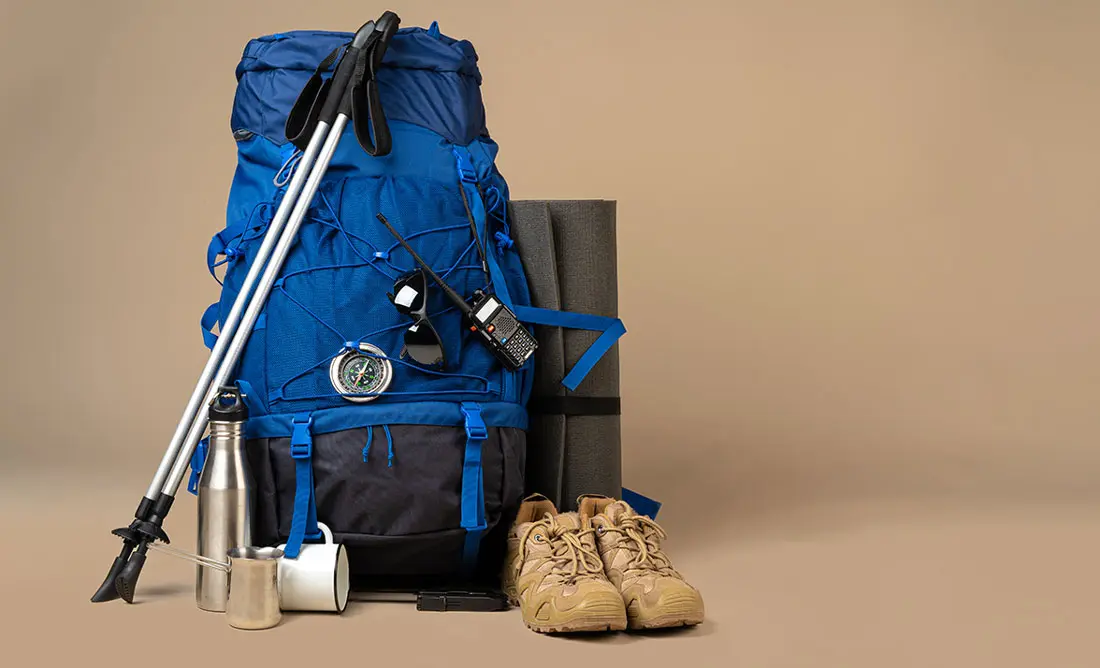
Frequently Asked Questions(FAQ)
To register with TTH, visit our website - www.trekthehimalayas.com and create your account. To create your account you will need to use your email address and fill in all the details, set your unique password and your account is ready to use.
- To book a trek with TTH, you first need to register with us and create an account.
- Choose the trek that you want to do and click on available dates.
- You will land at the login page, fill in the required details.
- Add Participants, choose add-on services click on the Pay now button, choose your preferred payment method, and make the payment. TTH accepts multiple payment options, including credit/debit cards, net banking, and UPI.
- You will receive a confirmation email from TTH with all the necessary details about the trek, including the meeting point, transportation, accommodation, and other important instructions.
- Click Here to watch Video
please send an email to us at info@trekthehimalayas.com or reach out to the numbers provided in the Help and Support section of your Trek Page. We will ensure that your issue is promptly resolved.
To book services such as off-load luggage and transportation, you can find them listed as add-ons. These additional services can be booked at the time of your initial booking. If you miss booking add-ons during the initial reservation, you can log in anytime and easily book 4 days before the departure date add-ons through the platform.
If you have booked the wrong trek or selected the wrong date, don’t worry! You can contact us at +91 9368882322 (Monday to Saturday, 10 AM to 10 PM) or email us at info@trekthehimalayas.com. You can also discuss this with your trek coordinator. Please make sure to inform us at least 10 days before the departure of your trek. Only then can we help you reschedule or arrange another trek for you.
We recommend visiting our "Suggest Me a Trek" page. By filling out the form, our experts will contact you with the best possible trek options based on your preferences and experience level. Alternatively, you can reach out to us via email at info@trekthehimalayas.com or give us a call using the numbers provided on our website for personalized assistance and recommendations.
Family treks differ from regular treks by focusing on ease of difficulty, offering shorter durations for younger participants, Kid-friendly and easily digestible foods, child-friendly activities, maintaining a higher guide ratio for diverse age groups, and implementing additional safety measures for families.
Family Trek with Kids recommendation Only Dayara Bugyal and Chopta Chandrashila Trek.
Minimum age for TTH treks is typically 7 years, though this may vary depending on the specific trek.
Yes, you can take a kids to a high-altitude trek with a parent. Discuss with a trek expert before booking a trek.
- Junior trekkers (below 15 years) should have a company of parents/guardians.
- Trekkers between 15 to 18 years can come solo with the disclaimer form signed by parent/guardian.
- Medical & Disclaimer Form (Mandatory Documents) Click here to download medical and disclaimer form
Physical Fitness: Ensure your child is physically fit. Engage them in regular exercise, outdoor activities, and hikes to build stamina and endurance. Hydration: Emphasize the importance of staying hydrated at high altitudes. Encourage your child to drink water regularly, even if they don't feel thirsty. Proper Nutrition: Provide a well-balanced diet with sufficient carbohydrates for energy and foods rich in iron to prevent altitude sickness. Adequate Sleep: Ensure your child gets enough sleep in the days leading up to the trek. Quality rest is crucial for altitude adaptation. Educate on Altitude Sickness: Teach your child about the symptoms of altitude sickness, such as headache, nausea, and dizziness. Encourage them to communicate any discomfort immediately. Appropriate Clothing and Gear: Dress your child in layers to adjust to changing temperatures. Ensure they have appropriate trekking gear, including sturdy footwear. Positive Mindset: Foster a positive mindset. Encourage your child, and let them know it's okay to take breaks when needed. Medical Check-Up: Schedule a medical check-up before the trek to ensure your child is fit for high-altitude activities. Consult with a healthcare professional about any potential health concerns.
TTH takes special care to provide wholesome and nutritious food for children on treks. Here are some of the foods that are typically served for children:
Breakfast: For breakfast, TTH serves a variety of options like porridge, cornflakes, bread, butter, jam, honey, boiled eggs, omelettes, and pancakes. Children can choose from these options to fuel themselves for the day's trek.
Lunch: For lunch, TTH serves lunch which includes rotis, vegetables, rice, dal, and salad. The rotis are usually made fresh on the trek and are a good source of carbohydrates. The dal and vegetables provide protein and other essential nutrients.
Snacks: TTH provides healthy snacks like fresh fruits, dry fruits, energy bars, cookies, and biscuits to keep the children energized throughout the day.
Dinner: For dinner, TTH serves a hot and wholesome meal which includes soup, rice, dal, vegetables, and a non-vegetarian dish (if requested in advance). Children can also choose from a variety of desserts like custard, jelly, and fruit salad.
Dietary requirements: If a child has any special dietary requirements, TTH can cater to those needs as well. For example, if a child is lactose intolerant or allergic to nuts, the kitchen staff can make arrangements to accommodate those requirements.
Choosing the right trek for a beginner can be a bit overwhelming as there are many factors to consider such as distance, elevation gain, terrain difficulty, weather, and time of year. Here are some tips that can help you choose the right trek for a beginner:
1. Determine fitness level: Assess the fitness level of the beginner to understand their physical capabilities. This will help you select a trek that is challenging but not too difficult.
2. Choose a well-traveled trail: A well-traveled trail will have more amenities such as signposts, water stations, and shelter. It is also safer as there will be other hikers on the trail.
3. Consider the length of the trek: For beginners, it is recommended to start with a shorter trek that can be completed in a day or two. This will help them get acclimatized to trekking and build their confidence.
4. Look for gradual elevation gain: Choose a trek with a gradual elevation gain rather than steep ascents. This will make the trek easier and more enjoyable.
5. Check the weather: Check the weather forecast before selecting a trek. Avoid treks during the monsoon season or winter when the trails can be slippery or dangerous.
6. Research the trail: Read about the trail to get an idea of the terrain, altitude, and difficulty level. This will help you select a trek that is suitable for the beginner.
7. Consult with an expert: If you are unsure about which trek to choose, consult our trek expert Mr. Nitin (+91 70600 59773) between 10 AM to 6 PM (Tuesday - Friday). Mr. Nitin will provide you valuable advice and guidance.
Overall, it is important to choose a trek that is enjoyable, challenging but not too difficult, and suitable for the beginner's fitness level and experience.
It is not recommended for a beginner to choose a difficult Himalayan trek. Trekking in the Himalayas can be physically and mentally challenging, especially if you are not used to the high altitude, steep slopes, and rugged terrain. Choosing a difficult trek without the proper experience, fitness level, and preparation can be dangerous and put you at risk of altitude sickness, injury, and other hazards.
If you are a beginner, it is recommended to start with an easier trek and gradually build up your skills and experience. This will help you understand the challenges of trekking in the Himalayas, and also prepare you physically and mentally for a more difficult trek in the future. It is also important to choose a trek that matches your fitness level, experience, and interest.
There is no specific age limit for a beginner trekker. However, it is important to consider your physical fitness, health condition, and personal interests before embarking on a trek. Trekking in the Himalayas can be physically and mentally demanding, and requires a certain level of physical fitness and endurance.
If you have any pre-existing medical conditions or are above a certain age, it is recommended to consult with a doctor before embarking on a trek. It is also important to listen to your body and take breaks as needed during the trek to prevent exhaustion or injury.
We recommend visiting our "Suggest Me a Trek" page. By filling out the form, our experts will contact you with the best possible trek options based on your preferences and experience level. Alternatively, you can reach out to us via email at info@trekthehimalayas.com or give us a call using the numbers provided on our website for personalized assistance and recommendations.
Yes, you can join the trek. We have fixed departure groups where you can simply book your trek and we will take care of curating a group.
Before you start the trek, it is recommended that you make all the necessary phone calls as during the trek you may or may not receive network coverage, once you come back to the Base Camp, you can reconnect with your family via phone once again. You can share your trek coordinator contact detail with your family members to get the latest updates about your trek batch.
At TTH, we provide wholesome and nutritious meals during the trek. The food is vegetarian and includes a variety of dishes such as rice, dal, vegetables, chapati, paratha, pasta, noodles, and soup. We also offer snacks such as biscuits, and salty, and dry fruits during the trek. Special dietary requirements such as vegan, gluten-free, or Jain food can also be arranged if informed in advance.
If you are allergic to some foods, you need to let us know in advance so that we can make arrangements accordingly.
TTH is a trekking company that prioritizes the safety of all its participants, including women trekkers. We have a comprehensive safety system in place, which includes a dedicated team of experienced and trained trek leaders and support staff who are equipped to handle emergency situations and provide first aid.
TTH also takes specific measures to ensure the safety and comfort of women trekkers. They have a separate tent accommodation for women trekkers, female trek leaders, and support staff. They also provide separate toilet facilities for women and encourage a safe and respectful environment for all trekkers.
Moreover, TTH has a strict policy against any kind of harassment and has a zero-tolerance policy towards such incidents. They have a designated Internal Complaints Committee (ICC) to investigate and address any complaints related to harassment or misconduct. Overall, TTH has a good reputation for safety and responsible trekking practices, and women can feel comfortable and safe while trekking with them.
In case you are the only women in the group, we provide a single sleeping arrangement. Also, during the trek, the trek leader will always remain by your side to provide optimum safety and reassurance.
You can reach out to the trek coordinator to inquire about the number of female trekkers and their respective states who have booked the trek. Please note that the trek coordinator cannot disclose personal details of any trekker. Once you've confirmed your booking, a WhatsApp Group will be created for all the trekkers in your batch. This allows you to connect with fellow trekkers before the trek begins.
While many of our treks are led by female trek leaders, however, it is not possible to know which trek leader is assigned to which group. But nonetheless, whether the trek leader is male or female you can be completely assured of your safety and security with us.
Yes, it is possible to trek with periods. However, it is important to take some extra precautions and preparations to ensure a comfortable and safe trekking experience. Here are some tips that can help you trek during your period:
1. Use menstrual hygiene products that you are comfortable with, such as tampons, pads, or menstrual cups. It is recommended to carry enough supplies for the entire duration of the trek.
2. Pack wet wipes, hand sanitizer, and plastic bags to dispose of used hygiene products.
3. Wear comfortable and breathable clothing that allows for easy movement and reduces friction. Avoid wearing tight or restrictive clothing that can cause discomfort.
4. Carry pain relief medication, such as ibuprofen or acetaminophen, in case of menstrual cramps.
5. Stay hydrated and maintain a balanced diet to support your energy levels and overall health.
6. Take breaks as needed and listen to your body. If you feel uncomfortable or experience any unusual symptoms, seek medical attention immediately. It is also recommended to consult with a doctor before going on a trek during your period, especially if you have a pre-existing medical condition or are taking medication.
By taking necessary precautions and being prepared, you can have a safe and comfortable trekking experience even during your period. We provide proper disposal facilities for sanitary pad disposal during the trek.
We offer three person tents with twin-sharing for optimum comfort. A woman trekker will share a tent with another woman trekker and if you are the only woman in the group, you will be given a single accommodation for your comfort and privacy.
Yes, we do provide gears on rent. You can book it using you TTH account directly.
Mountaineering qualified Experienced and first aid certified Trek Leader, First Aid Certify local guide, Cook, helpers and supporting staff.
People suffering from Bronchitis, Asthma, High blood pressure, Epilepsy (got faints), TB , Heart problem or on higher BMI side are strictly not allowed to go on any Himalayan trek. Apart from this if you had any medical history, please let us know.
No. Alcohol and smoking isn’t allowed while on trek. It is totally misconception that it will keep you warm. Your body need to acclimatize properly and for that eat properly and drink enough water; these things will keep you warm.
Toilet tents provide a convenient solution for answering nature's call in the great outdoors. Dry toilets, in particular, offer a highly sanitary approach. By digging a pit and utilizing mud and a shovel, you can easily cover up your waste. This method ensures cleanliness and hygiene while camping or exploring in the forest.
Remember to pack essential toiletries to complete your outdoor bathroom kit and maintain proper personal hygiene during your adventures. With these practices in place, you can enjoy nature while also respecting it.
Layer Up From Head To Toe
Eat Full Meals, never sleep empty stomach
You can keep warmee (if you’re more susceptible to cold).
Use sleeping bag in right way and don’t leave free space in sleeping bag.
For upper body
– Thermal layer
– T-shirt (full-sleeves)
– Fleece T-shirt (for extreme colds)
– Fleece layer
– Thick Jacket/Down Jacket
– Waterproof or Windproof layer (outermost layer, when it is snowing or raining)
- For Lower Body
– Thermal layer
– Hiking pants (normal) or Winter hiking pants
Based on how warm you feel you can skip any of the above layers. Your outer later should be windproof since it is windy at high altitude.
The idea behind layering is that the more insulation you have the less cold you feel, and instead of wearing a very thick jacket if you wear multiple layers, your body will be better insulated against the cold.
Yes, we provide micro spikes and gaiters, if required.
Mandatory documents: 2 xerox of ID having address (addhar card/driving license), 2 Passport size photographs, hard copy Medical form signed & sealed by doctor, disclaimer form sign by trekker and high altitude insurance.
No. We don’t but we can suggest you good hotel/Stay nearby pick up location.
Yes, trekker must carry 2 water bottles 1 litre each so they can refill it at campsite for drinking and keep themselves hydrate.
You should buy shoes which has these three features –Good grip, Ankle Support and additional water resistant layers. Generally, we advise Quechua Trek 100, MH 500 and MH 100.
No one is forced to go on. There is always enough staff to split the party according to need and regroup later at the camp. Most people have no trouble reaching the highest campsite. If some members decide not to climb the final distance they can wait for the climbers to come back down the same way or take a lateral path to the descent route.
The Manali to Leh Cycling Expedition is approximately 505 km long, depending on the route taken.
The best time to do the Manali to Leh Cycling Expedition is from June to September, as the roads are clear and the weather is pleasant during this time.
The altitude of Khardung La is 5,357 meters (17,577 feet) above sea level, making it one of the highest motorable passes in the world.
The Cycling Expedition from Manali to Leh via Khardung La is considered to be challenging, as it involves cycling at high altitudes and steep inclines. It is recommended that cyclists have prior experience in long-distance cycling and have trained for the expedition.
While it is not mandatory to have a guide, it is highly recommended to have one as it can provide valuable guidance on the route, weather conditions, and safety.
A sturdy mountain bike with good suspension and wide tires is recommended for the Cycling Expedition.
Accommodation options include guesthouses, campsites, and homestays. It is recommended to book accommodation in advance, especially during peak season.
Yes, cyclists need permits to enter certain areas along the cycling route, including the Rohtang Pass and the Nubra Valley. These permits can be obtained from the local authorities in Manali and Leh.
Cyclists need to have appropriate cycling gear, warm clothing for high-altitude conditions, and a first-aid kit. It is also important to carry sufficient food and water, and any necessary medication.
While the Cycling Expedition can be challenging, it is generally considered safe as long as cyclists follow safety guidelines and take appropriate precautions.
Basic medical facilities are available along the cycling route, but they may be limited in some areas. It is recommended to carry any necessary medication and consult a doctor before embarking on the expedition.
It usually takes around 12 days to complete the Cycling Expedition from Manali to Leh via Khardung La, depending on the route and the fitness level of the cyclist.
The route of the Cycling Expedition typically includes Manali, Rohtang Pass, Keylong, Baralacha La, Sarchu, Nubra Valley, Khardung La, and Leh.
Yes, bikes can be rented in Manali and Leh, but it is recommended to bring your bike or rent it from a reputable rental agency.
The weather can vary significantly during the cycling expedition, with temperatures ranging from below-freezing to over 30°C. Cyclists should be prepared for both hot and cold weather conditions.
CyclingExpedition/Slider/76bad908-1109-427b-8d7d-c54a1663e163_Manali---Leh---Cycling.webp)
CyclingExpedition/MobileSlider/98abe6ff-3920-40c4-92dd-0a57a55f2e4a_Manali---Leh---Cycling.webp)



